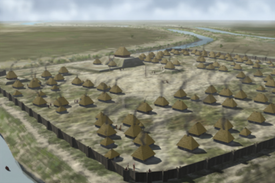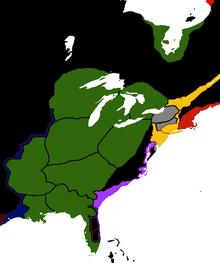| |||||||
| Capital | Cahokia | ||||||
| Largest city | Cahokia | ||||||
| Other cities | Moundville, Parkin, Etowah, many more | ||||||
| Language | Cahokian | ||||||
| Religion main |
Catholic | ||||||
| others | Southern Cult (SECC) | ||||||
| Ethnic Groups main |
Mississippian | ||||||
| others | Algonquin | ||||||
| Demonym | Cahokian | ||||||
| Government | Constitutional Confederation | ||||||
| Legislature | Grand Council | ||||||
| Great Chief | Zacharie | ||||||
| Area | 2,385,150 sq km (1580) | ||||||
| Population | 9,329,061 (1580) | ||||||
| Established | 1533 (as the Cahokian Empire) 1558 (as the Mississippian Confederation) | ||||||
Having its roots in the Cahokian civilization based around the city of Cahokia, the Mississippia Confederation was declared in 1533 as the Cahokian Empire, under Great Chief Antinanco the Restorer. Mississippia spans from Florida to Minnesota, along the Mississippia River, and includes a blend of many different people united in common Mississippian heritage.
The Confederation
The current ruler is Christophe the Christian, who is overseeing a period of Christianization and continuing modernization in Mississippia.
History[]

Cahokia, ca. 1400
Early History (Pre-1400)[]
The early history of Mississippia was based in a series of similar cultures that all evolved into the modern Mississippian culture. Mississippia's first true predecessor was the Woodland Culture. The Woodland Culture was the dominant Borealian culture from 1000 BC to 1 AD, at which point it was overtaken by the Hopewell Culture.
The Woodland culture saw continuous change in the lifestyle of the people over the generations. Use of stone and bone tools increased, as did skills in leather crafting, textile manufacturing, farming, and engineering. The most lasting influence of this time was that the nomadic peoples of Borealia settled down into towns and organized settlements during the Woodland culture's dominance.
The Hopewell tradition was the second formative period of the early history of Mississippia. Involving extensive trade networks that spanned the eastern half of Borealia, the Hopewell tradition was the direct predecessor of both the Mississippian culture and the Algonquin culture. The period also saw two major trends. In addition to increases in technology: mound-building became popular, as did the migration from the coast to the Mississippia River and its tributaries.
Following the split of the Hopewell culture, the Mississippian culture became the dominant power in eastern Borealia. The use of metals began in the Mississippian period from 500 to 1200 AD. Notably, copper was worked into Mississippian tools. By 1200 AD, the largest city under the culture, Cahokia, began more and more to dominate the trade and culture of the region.
The city of Cahokia, which had been established by 600 AD, came to dominate the Mississippian region near 1200 AD, due to its location at the confluence of the Mississippia, Missouri, and Illinois Rivers. The Chief of Cahokia began to expand his sphere into the rest of Middle Mississippia, but by 1350, a small decline in Cahokian power began to develop.
1400-1533[]
This decline was quick to be reversed however; in approximately 1400, droughts began to appear along the Mississippia region. Cahokia, being the largest city in the region, was flooded with refugees, making the city even more powerful. The city was also relatively unaffected by the droughts, which allowed the city to recover from its decline, under the leadership of Great Alligator.

Picture of Cahokia
By 1410, knowledge of iron working was discovered and began to be put into practice to use farming tools and weapons, making Cahokia the most powerful state in Borealia. Its supremacy ended up somewhat challenged by Moundville, which developed towards the south, but Moundville ended up reliant upon Cahokia for trade and ended up with great cultural similarities that continue to unite the region to this day.
Cahokia began to develop a greater structure to house its entire government -- the Epic Flying Serpent Mound as the population of the city began to skyrocket. By 1418, Cahokia dominated the majority of the Mississippi River as the Moundville culture was vassalized.
By 1430, it became quite clear that Cahokia had expanded much too rapidly, as some resistance began to be experienced in addition to internal political fighting. However, with the leadership of Rektaw the Proud in 1440, Cahokia quickly began to expand yet again.
Notably, major developments were made in the fields of sanitation and revival of the medicine man culture. A medical school was established in Cahokia in 1457, and a massive sanitation/sewer/water management plant constructed by 1468, under the reign of Galegenoh.

Picture of Parkin, a Cahokian Vassal
Cahokia then engaged in decades of peace and consolidation. Population exploded throughout the realm and all of the vassals began to merge into a common Mississippian culture. The medicine men who spread the Southern Cult religion were also influential in maintaining the culture in the vassal states.
With the arrival of Europeans to Borealia in the early 1500s, diseases began to spread. Therefore, the population thinned out and the economic growth slowed proportionally. During the period of disease, the medicine man began to turn to science in order to prevent massive spread of the disease. In total, about 50% of Cahokians and their vassals died.
The Great Chief of the time, Diwali the Lame, proved incompetent to run the nation and was unable to handle the frequent rebellions. When he died in 1533 under suspicious circumstances, the House of Rektaw, which had ruled for 93 years, had come to an end, and with it came the emergence of a new period of Mississippian history - the creation of the Cahokian Empire and Mississippian Confederation.
1533-1583[]

In 1533, the Grand Council of nobles elected a new royal house after Rektaw's family died out without a strong male heir. Antinanco, the new Great Chief, was deemed to be an Emperor, creating the Cahokian Empire, which evolved into the Mississippian Confederation.
The Mississippian Confederation would later collapse in 1583.
Government[]
The government of Mississippia is a confederative central tribal chiefdom. What this means is that there is one central government overseeing a confederation of states (confederate members) and that these confederate members are also comprised of smaller tribal governments.
- See also: Great Chiefs of Mississippia and Constitution of Mississippia
Confederate States[]

1560
 Cahokia - Illinois, Michigan
Cahokia - Illinois, Michigan Moundville - Alabama, Florida
Moundville - Alabama, Florida Etowah - Kentucky, Tennessee
Etowah - Kentucky, Tennessee Parkin - Arkansas
Parkin - Arkansas Odawa - Southern Ontario, CA
Odawa - Southern Ontario, CA Santee - Minnesota, Wisconsin
Santee - Minnesota, Wisconsin Aksimiki - Northeastern Ontario, Northwestern Quebec
Aksimiki - Northeastern Ontario, Northwestern Quebec Erie - Ohio, Pennsylvania
Erie - Ohio, Pennsylvania Natchez - Louisiana
Natchez - Louisiana
Census[]
| Nation | 1570 | 1580 |
|---|---|---|
| Cahokia | 1,915,900 | 1,735,159 |
| Moundville | 1,511,925 | 1,236,488 |
| Etowah | 1,108,943 | 1,564,273 |
| Parkin | 879,094 | 1,240,048 |
| Odawa | 406,745 | 631,662 |
| Santee | 341,204 | 545,289 |
| Aksimiki | N/A | 512,504 |
| Erie | N/A | 967,407 |
| Natchez | N/A | 896,231 |
| Total | 6,163,811 | 9,329,061 |
Economy[]
Mississippia has the strongest native economy in Borealia, due to extremely productive farming, trapping and trading with various European nations and other American Indian nations.
The large population also helps support an extremely wealthy economy.
Trade[]
Trade is a large sector of the Mississippian economy. The location of Cahokia at the confluence of the two longest rivers in Borealia (the Mississippia and the Missouri) and the Illinois River, made it an ideal location for continental trade prior to the arrival of Europeans.
Since the arrival of Europeans, trade has generally been focused closer towards the coastlines. The Mississippians also are making a large profit as a middleman: Mississippia bought good from the inland tribes to sell to colonizers and bought European goods to sell to inland tribes.
The construction of roads, which began under Christophe the Christian and was overseen by Jean-Frances Desjardin, furthered the ease of access for trading. Additionally, the importation of horses and their subsequent rise in population greatly expanded Mississippian trade.
OTL/ATL Locations[]
- See also: Places
Geography[]
- Mississippia River - Mississippi River
- Gichigami - Great Lakes
- Mishigami - Michigan Panhandle
Cities[]
- Cahokia - St Louis, MO
- Miami - Detroit, MI
- Moundville - Tuscaloosa, AL
- Whapeton - Twin Cities, MN
- Huron - Toronto, ON, CA
- Adena - Columbus, OH
Culture[]

Extent of Mississippian Culture, 1400
Mississippian culture has a few defining features that unite all of the Mississippian Confederation. These features are:
- Mound-based architecture (pyramids, squares, circles);
- Cultivation of corn for the majority of food produce;
- Deeply interconnected trade networks across Borealia, from the east coast to the west coast;
- Complex imperial system of tribal and inter-tribal confederations;
- Use of iron tools; and
- Southern Cult (Southeastern Ceremonial Complex), a complicated religion that is dying as Christianity is rising.
Based upon these definitions, the area shown at the right is defined as Mississippian in 1400.
Since 1500, the culture has started to adopt Christianity, due to increasingly present French and European traders and missionaries.
The Mississippian language was never written down, but increasing use of French and Latin by medicine men has begun a small cultural revolution that is displacing some Mississippian cultural elements.
Foreign Relations[]
The foreign relations of the Mississippian Confederation are based around ...
- Allied
- Zapotec
- Rome
- Friendly
- Colorado
- France
- Neutral
- Hostile
- New Pomerania
- Scandinavia
- War
To Do[]
- Terraforming
- Connect Kankakee River with Great Lakes (20 miles)
- Connect Allegheny River to Genesee River in PA (13 miles)
- Thicken St Clair and Detroit Rivers
- Connect the Pigeon and Rainy Rivers at the Height of Land Portage in order to break the Laurentian Divide
- Get guns, horses, and modern tech
- Continue to develop agriculture
| ||||||||||||||||||||
| ||||||||||||||||||||||||||||||||||||||||||









